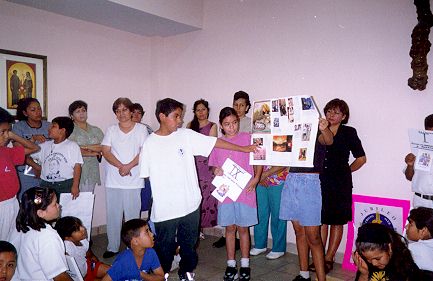
Pan de Vida Community
| Home |
| Phylosophy |
| Ministries |
| Activities |
| CEDIMSE Wants to Answer |
| From Yesterday up Today, and from Today for Tomorrow |
| The Women's Situation |
| Thematic of the Women |
When you dream alone, it's only a dream; when we dream together, the dream becomes a reality
Seven years ago the Benedictine sisters of the monastery Pan de Vida have arrived to Torreón with a drean; and in January of this year we have seen carried out an important part of our vision.
But
it's better to go one step back. It is necessary to begin wondering, because there will be
who asks: “And who the Benedictine sisters are?” or “what is a
monastery?.”
We are Althea, Mariana, Maricarmen, Michele and Patricia. We belong to San Benito's Order,
one of the oldest orders of nuns of the Catholic church. Our founders are San Benito of
Nursia and their sister Santa Escolastica whose parties take place July 11 and February
10, respectively. In the VI century Benito and Escolastica responded to a call of God and
they formed men's and women communities that, taking for guide the Gospel, they followed a
small RULE OF LIFE that Benito wrote.
San Benito's Rule calls us to live in stable communities, in obedience, with a common pray, and to the service of the people from our surroundings, the life of San Benito's followers calls you monastic life; the place where we live calls himself monastery.
A Benedictine community tries to offer a human and balanced atmosphere to be able to live the comptemplation in the action. As this it is necessary in all the times and places, the Benedictine communities extended for all Europe in the Medieval Times, by the United States of North America in the XIX century, and in Mexico from half of the XX century.
In July of last year, the oldest Benedictine monastery, in Subiaco, Italy, celebrate it's 1500 years since San Benito began a "school for the service of the Lord".
In that occasion, Their Holyness John Paul II said: “Want God that each Benedictine community is presented with a VERY DEFINED IDENTITY, different from the world that surrounds it, but open and welcoming with regard to poor and peregrine people and to everyone that looks for a life of more fidelity to the Gospel.
This is what we
have wanted to make here in Torreón: to make an effort to live the Benedictine charisma,
looking for God in community, with a “unyielding fidelity to the word of God,
meditated and welcome through the Divine Lectio”. Taken root in our tradition, we
have made a preferential option for the women, mainly the neediest that surround us. This
commitment is deepened every time that we meet to divide and share the bread of the table,
the Word and the Bread of Life that strengthen us, they illuminate and they impel. Of
there our name.
A lot of people, when listening the word “monastery”, thinks of a
community of monks or of cloister nuns. And when they hear speak of
“Benedictine” they are accustomed to think in big choirs praising to God with
the Gregorian song or in people in long habits copying manuscripts in the library of a
majestic medieval abbey.
In fact, in the Comarca Lagunera there are two cloister monasteries: one of the Hermanas de la Visitación, in San Pedro de las Colonias, and the other is from the Carmelitas Descalzas in Gómez Palacio.
Our
modern founders, the Benedictine that arrived more than century and half ago to North
America from Germany, were forced to leave the cloister to respond to the urgent
necessities of the People of God that surrounded them. Of there it arose and it continues
giving abundant fruits a new branch of the great tree of Benedictine life: the Benedictine
sisters of active life.
We continue giving a central place to the Liturgy of the Hours in community, but we have
looked for simple melodies and new ways of reciting the psalms that facilitate sharing our
Pray with the People of God. We have rediscovered the great wealth of making Lectio, that
praying and reflexive way of to read and to apply the Word of God, and to apply it to the
life, when making it in community with our neighbors and oblatas. Our “cloister”
it is a simple and practice from of dressing to carry out our work and to serve everyone.
Instead of copying manuscripts in a great monastic library, we want to put to the service
of the surrounding hills a small library with basic elements of evangelización and
culture; and we enter to the Internet to have access to the most recent information about
the situation of the women, to be able to serve them better.
We don't fulfill the Benedictine stereotype very well; but, in fact, what has allowed that the Benedictine order lasts fifteen centuries and continue offering its charisma to the People of God it has been its capacity to adapt to new circumstances without losing the essential of San Benito's message.
You could find us in the monastery preparing the food, washing the floor or praying eves; the same as in the Instituto Pablo VI, giving a class; in the house of a neighbor giving the communion to a sick person; teaching catechism or, in CEDIMSE, facilitating a workshop with women from different parts of the Diocese.
As
Benedictine presence in the suburban area, we share the monastic values through our
community life, the hospitality, the pray, the service, and the care of the creation. We
assume the Diocesan Pastoral Plan joyfully in our ministries, and we assist the women
prioritarily in our Center of Integral Development of the Mujeres “Santa
Escolastica.”.
In this jubilation year we thank God for the so warm welcome we have received here in the
Comarca Lagunera; for the opportunity of spread the seeds of the Benedictine charisma in
this semi-desertic earth; for the help and the support of so many people that have made
possible our presence and growth here; because we feel each day of our lifes that His
mercy is eternal.
After seven years in the Diocese of Torreón, significant number in this jubilation year, the Benedictine sisters have been able to carry out the dream of the construction of a building for the activities of CEDIMSE, S.C., the Center of Integral Development of the Women “Santa Escolástica.”
Since Don Luis Morales Reyes received us in 1992, and welcomed with enthusiasm our project, we have lent some services at local, regional and national level in favor of the women. Now, for the first time, we have appropriate facilities to continue and to enlarge our work.





